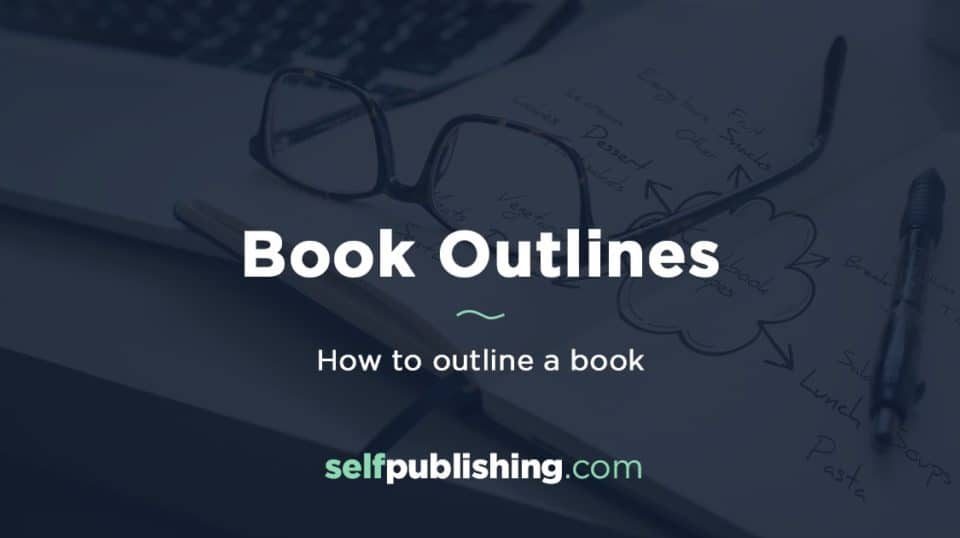Book Outline: How to Outline a Book [Template Included]
Book outlines are crucial when writing a book, so it’s important to learn how to outline a book in the most effective way for your readers.
A book outline is the foundation for an organized writing process, and it can be used as a roadmap for your book.
No matter how skilled you are as a writer, you’ve no doubt experienced the dreaded blank page syndrome, or writer’s block as it’s commonly referred to.
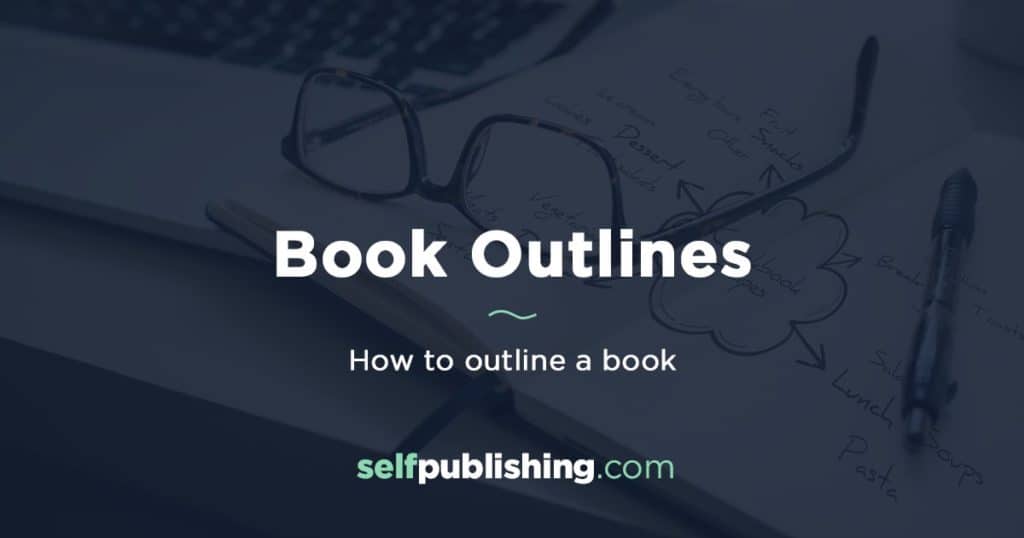
From aspiring authors to professional novelists, writing a book is challenging.
You know how daunting of a task it can be to string together a fluid sequence of words that accurately conveys a thought or concept.
But you don’t know how to outline a book or novel the right way.
Related: How to Write A Novel
In this post, you’ll discover how to create a book outline that will help you start, and finish, writing your book.
Here’s all you need to know about a book outline:
- What is a Book Outline?
- Do You Need a Book Outline?
- Reasons to Outline Your Book
- Book Outlining [TEMPLATES]
- How to Outline A Book [General Process]
- How to Outline a Novel
- How to Outline a Nonfiction Book
- Book Outline Strategies
- Book Outlining Tips
What Is A Book Outline?
A book outline is a structured document that plans out and sequences the information that your story will include. It is a wireframe or skeleton of your book, and will be used as the roadmap during your writing process.
Your book’s outline is an agenda, or roadmap, that includes the main points or events that you will write about in your book.
It’s not uncommon to use a map (or GPS) when we go on holiday. And certainly, if we want to build a house, we use a blueprint. In football, the coach puts together a game plan. All of these make the actual task easier (sometimes it makes the task possible).
Writing an outline for your book serves the same purpose – it is a guide that you can follow to write your book.
A book outline will essentially be the same concept for both fiction and nonfiction books, but the outline format and style will vary on the genre.
- A fiction novel will include important storytelling aspects such as structure, plot, scenes, and characters.
- A nonfiction book will include important information aspects such as topic clusters, concepts, and intentional information architecture.
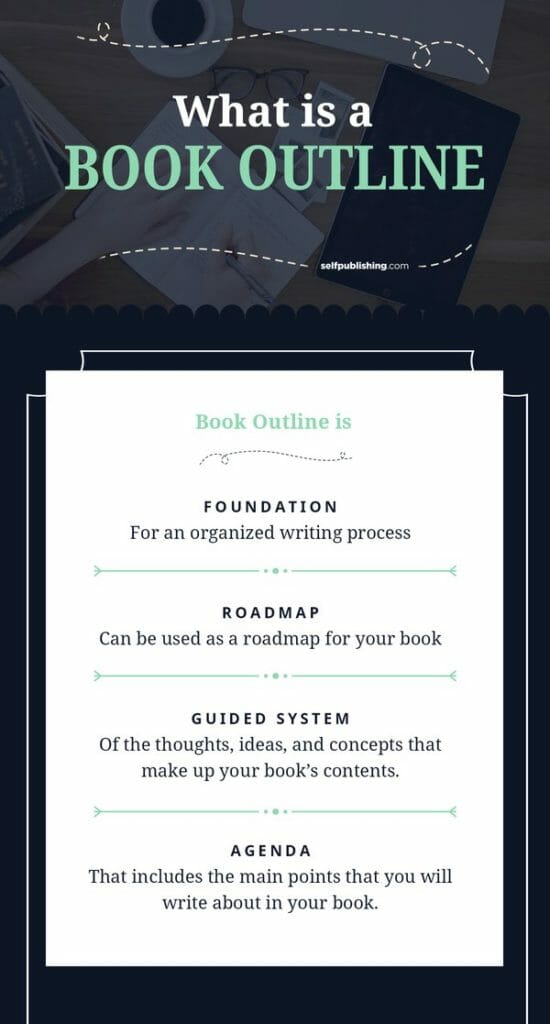
Do You Need A Book Outline To Write A Book?
Without an outline, it will take a lot longer to finish your book, and it may hinder the book’s quality and reader experience. You may not need a book outline, but it will certainly help you write faster and with better quality.
Think of a book outline as a writer’s plan. When you outline a novel or book, you are creating a plan or roadmap of your book’s contents.
To outline or not to outline? Is it more difficult to write a book without an outline? Are there benefits to outlining a book?
These are just some of the questions you may have. But there is not one answer, and certainly not one way on how to outline a novel.
“I always have a basic plot outline, but I like to leave some things to be decided while I write.”
J.K. rowling
Related: Writing Quotes By Famous Authors
Many successful authors know not to underestimate the power of a book’s outline. Not only does it help in writing an organized book with clear direction, but it also helps fight writer’s block when you’re stumbling your way through a work-in-progress.
A good book outline changes and develops as you write.
And there really is not one single way to outline a book. Sure, there are templates to use, and models to follow, but every outline is different.
Book Outline Examples
Let’s take a quick look at some examples of famous authors who learned how to write a book outline that fit their needs, then went on to write and publish them successfully.
Below is the handwritten outline of novelist James Salter:
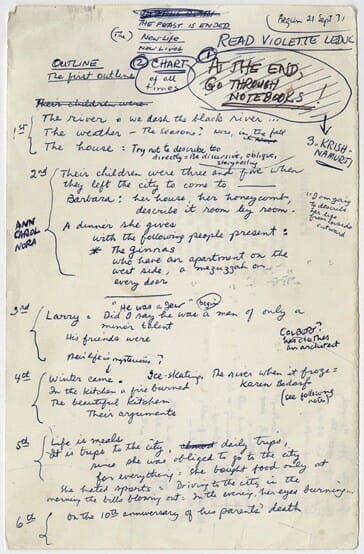
You may be familiar with this image of J.K. Rowling’s plot lines of the Harry Potter books…
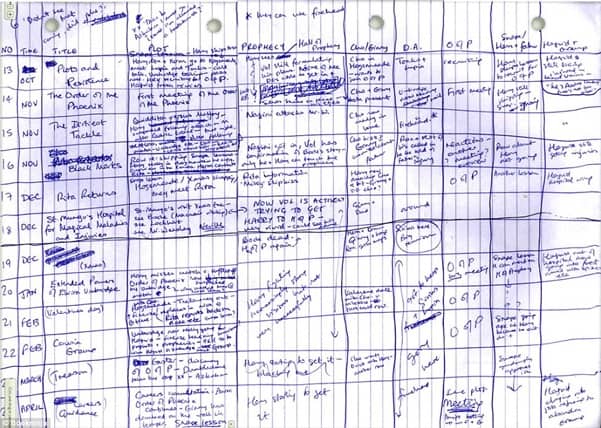
Famous outliners (or plotters) include John Grisham, J.K. Rowling, E.L. Stein, to name a few.
Related: How to Publish a Book
Reasons to Outline Your Book
The biggest benefit of learning how to write a book outline is that your outline can help you start, and finish your book.
It can make your process towards becoming an author easier, and more clear – with less detours and frustrations along the way during your writing process.
Here are some benefits to outline your book:
- Write quickly. With a book outline, you know exactly what you have to write about next.
- Intentional structure. Although an outline is equally applicable to nonfiction and fiction, an outline can help you create a solid structure for your novel. This can result in a better quality piece of literature.
- Overcome blank page syndrome. With an outline, the dreaded blank page is not as daunting as it could be. When you sit down to write, you will be able to kickstart your writing with an outline.
- Prevent writer’s block. Again, having an outline can help you eliminate writer’s block because you open your outline, and there you have the next piece to start writing. It’s like jump-starting the brain.
- Push through the sagging middle. If you’re writing a novel, you no doubt are familiar with the uphill battle of writing the sagging middle. With a carefully structured outline, this becomes easier.
- First draft. K.M. Weiland, in her book Outlining Your Novel says: “In many ways, an extensive outline is a first draft.”
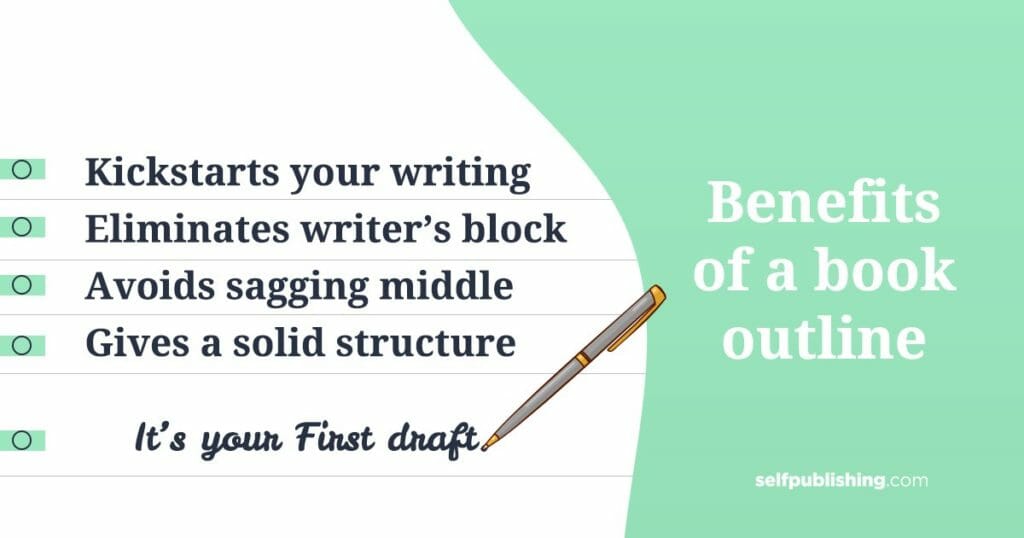
To write a nonfiction book without an outline, is an invitation to stress and frustration (and it may likely result in a sub-standard book).
To write a fiction novel without an outline is a bit more acceptable, because it’s more of a creative process. But you should still have an idea of your book’s starting and ending points to avoid writer’s block and overwhelm – especially if you’re a first-time author.
From the Introduction of K.M. Weiland’s book, Outlining Your Novel, she offers the following: “Outlining has transformed my own writing process from hit-and-miss creativity to a reliable process of story craft. Outlining allows me to ride the waves of my story with utter confidence, channeling the art into the craft to produce solid stories. And the best part about outlining? It’s entirely learnable.”
Free Book Outline Templates
A book outline template can make it super easy to get started writing your outline.
For FICTION, you can download the free template here.
For NONFICTION, you can download the free template here.
If you’re ready to get started, we have ready-made templates just for you.
Select your genre, and get a completed book outline that’s ready for you to plug in your book ideas.
Use this outline template tool as a starting point to write your book’s outline. It’s yours to adjust as needed!
How to Outline a Book in General
There is no single right way to outline a book. What works for you, may not work for another writer, and vice versa.
Don’t feel like you have to follow a rigid set of rules to craft your outline and get started writing your book. But, your book outline should have the basics covered.
It’s perfectly fine to start with a loose structure and develop your outline as you go.
So, how do you write an outline for a book?
Step #1 – Start with a one-line idea
Begin with a one-line idea. Write one sentence to summarize your book’s “big picture” idea. Although it sounds easy, summarizing the whole of your book in one single sentence can force you to strip away your ideas into one essential premise.
Step #2 – Brainstorm the 5 Ws
Do a brain dump. Brainstorm the main components of your book’s idea. A mindmap or bubble map is a popular method for this step. I start with drawing a bubble in the center of the sheet (usually with the chapter number and/or title), and then asking the 5W + H (Who, What, When, Why, Where, and How) questions in individual bubbles. I add snippets in between the bubbles as well.
When you start your outline, begin by asking the 5W + H questions:
- What? What is the concept, topic, or idea?
- Where? Where does this concept, topic, or idea, apply? Maybe it’s an event, or a context situation.
- Why? Why does this matter?
- Who? Who is this for, or who is involved?
- When? Is there a concept of time involved?
- How? If applicable, ask yourself how will this happen?
Working through your outline, asking and answering these basic questions, you will likely find you building a story that when you sit down to actually write your book, it will develop and grow almost magically. Give it a try.
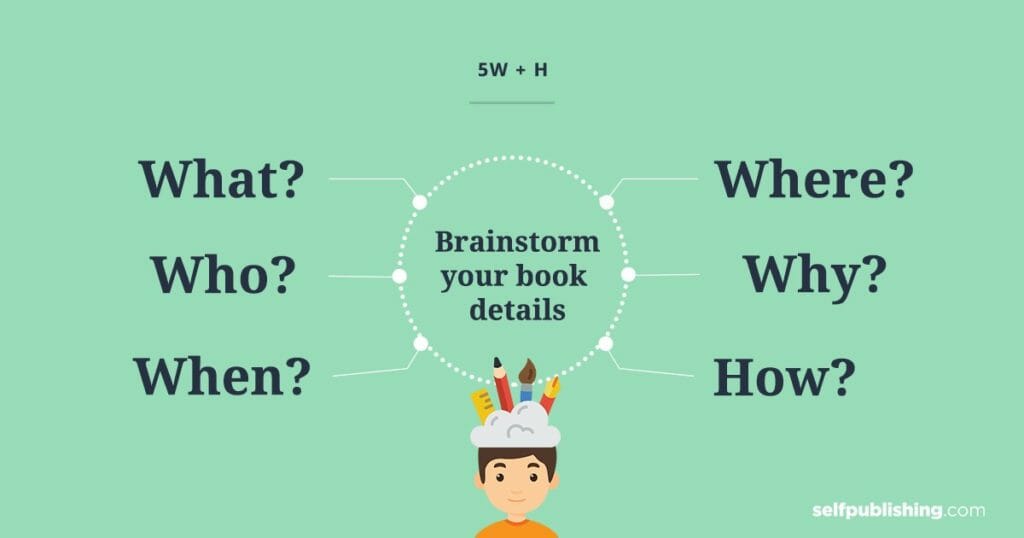
If you’re writing nonfiction, the value of questions is indispensable…
- What information do you want to share in your book?
- Who is your reader: beginner, intermediate, advanced?
- Why does your reader want to know the information in your book?
- What does your reader want to learn by reading your book?
If you’re writing fiction, questions can also help…
- If my antagonist does that, how will my protagonist react?
- How can I get my protagonist out of that jam?
- Use “What if?” in different scenarios.
Step #3 – Hash out the details
Narrow in on the essential details.
Now that you have the premise of your book’s idea, and you’ve had a chance to brainstorm all of your ideas, it’s time to get organized with the specifics.
Organize your book’s main points, and add in any specific details that you will have to touch on in each point.
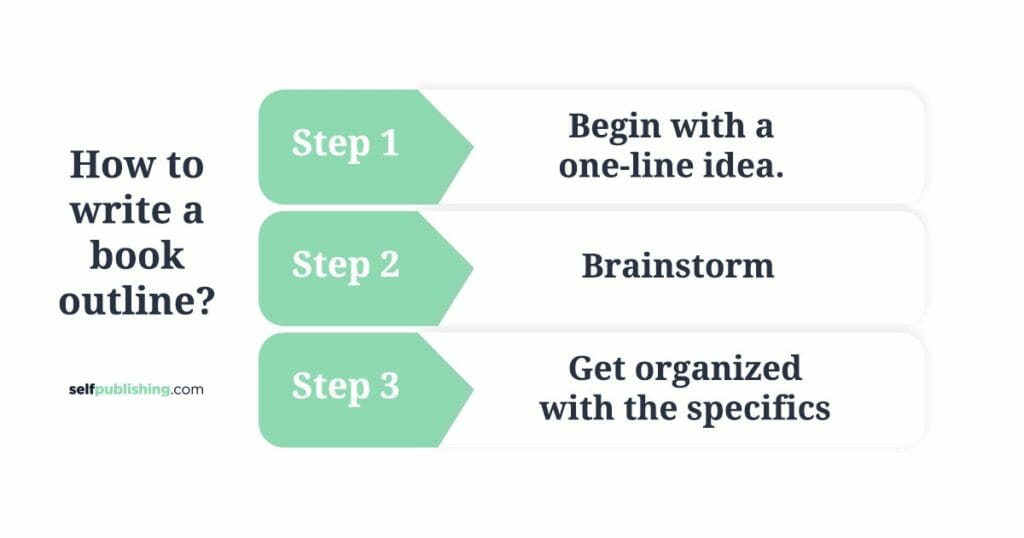
It’s important to note that the above steps are a loose starting point for any standard book idea. To really hone in and follow a book outline strategy, you need to know which type of book you are writing, since the outline can vary greatly depending on this.
Are you writing a novel, based on fiction, or are you writing a nonfiction book?
Let’s take a look at the next two sections to determine the process for each.
How to Outline a Novel
A novel is based on fiction, or imagination – it is not based on real life. If you are writing a fictitious narrative, then you need to create a novel outline.
Fiction and nonfiction books are very different, and while the steps to create an outline of a book can be similar, they are pretty different based on the book’s genre.
Learn how to outline a novel well, and you will improve your storytelling and reader experience tremendously.
The purpose of a novel is to entertain, and your book’s outline needs to be created with that in mind.
You are telling a story in a novel, and a well-structured book outline will help you create a roadmap to tell that story well.
Note: If you’re writing a memoir, your memoir outline will most likely resemble more of a fiction structure than that of a nonfiction structure.
Here are the the steps to outline a novel:
- Write your idea out. What’s your book’s big picture? This is the premise of your story; it’s the “big idea.” Try to write your idea into as few sentences as possible, preferably one. You’ll have a chance to get into the nitty gritty details later.
- Answer the 5 W’s (Who,What,When,Where,Why). Get clear on the essentials of your story. This will help guide you in determining how to create your book’s outline framework, and will also help you identify any major “holes” that you might have missed.
- Use a book outline framework or template. Choose a template to work with as a starting point, then make any adjustments as you see fit and start plugging in your contents.
- Create your plot. Start with a beginning, middle, and end. It’s perfectly fine if you don’t have a clear idea of every event in your book. You can flesh it out as you go, but you should have an idea of the starting and ending point, at the least.
- Add characters. Now that you have a plot, it’s time to include your characters. This is important because it helps you identify any supplemental characters you hadn’t yet thought of. It also helps you chart out your protagonist’s purpose.
- Plug in scenes. With a starting point for your plot, and an idea of which characters are needed, you can start plugging in the major scenes that will help tell your story.
How to Outline a Nonfiction Book
If you plan to write a nonfiction book, then you need to know how to create an outline for a nonfiction book.
While the process is similar to the fiction outline steps, it’s also very different, because of the differing structure.
Think about it: A nonfiction book is likely based on facts and real life, whereas a fiction book is based on imagination.
The purpose of a nonfiction book is typically to educate or inform, so you need a book outline that is structured to that purpose.
Here’s how to outline a nonfiction book:
- Write out your idea. Write your big book idea out in one to three sentences.
- Identify the purpose of your book. Think about the 5 Ws (Who, What, When, Where, Why) questions specifically in terms of the problem your non-fiction book is solving, or what purpose your book serves.
- Choose your book structure. Many nonfiction books follow a specific structure. Is it a problem and solution structure? Maybe it’s a compare and contrast, or a chronological structure? If you’re having trouble deciding, go back to your purpose.
- Use a book outline template. Start with a template, and fill in the details of your book as you go.
- Add your main points as chapters. Brainstorm the main points your book will discuss to convey the topic you’re writing about. Then, add these main points as chapters.
- Structure individual chapters with details. Once you have your main points mapped out as chapters, you can add the specific points or details that you will write about in each chapter.
- Write an outline for each chapter. Once you have your overall outline completed, you can hone in and continue developing it by creating an outline for each chapter.
Effective Strategies for Book Outlining
There are a lot of strategies and frameworks when it comes to writing a book outline. There are some effective ways to outline a novel or nonfiction book, and many authors find success using popular book outlining strategies.
Related: Book Template
Let’s dive into some book outlining strategies that you can consider for your own book outline. Just be sure to make tweaks to any process that you see fit for your specific needs and writing process.
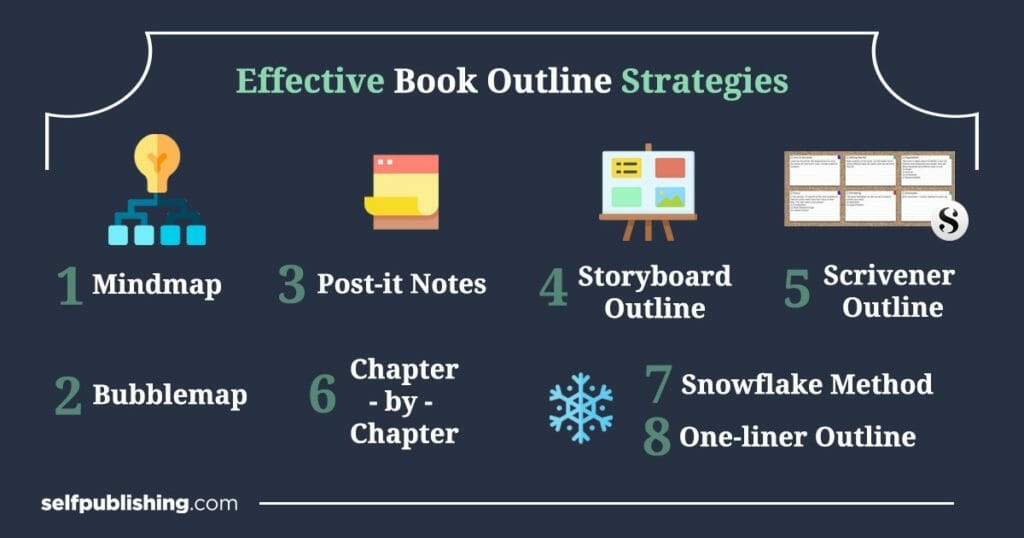
#1 – Mindmap
A mindmap can be done with software or with paper and pen. It’s a brain dump at its core – as you think of an item or point, you add it to your mindmap. This can be a few words, a line, a sentence, or whatever you need to get the basic idea down.
The first round of mindmapping is all about speed; get your idea out of your head into your mindmap. You can set a timer, and start mindmapping by allowing your thoughts and ideas to freely flow out of your head and into a visual scheme. Mindmapping is one of the best ways to outline a book.
#2 – Bubblemap
This is similar to the mindmap; the difference is that a bubblemap is usually done on paper or a white board. The same principles apply as with a mindmap: get the ideas out of your head onto paper (or white board). You may find that doing this on paper (or a white board), you’ll be able to get the ideas out of your head quicker. You can scratch out, add, and move items: it’s your outline, and you do it as you want to.
Below is an example bubble outline for a chapter in my forthcoming book (as you can see, it looks similar to a mindmap).
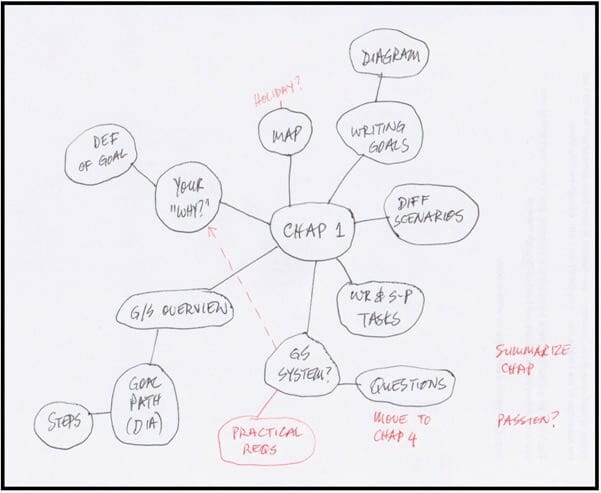
#3 – Scrivener Outline
Scrivener is a popular paid book writing software used by many expert authors. To create an outline in Scrivener, you would use the Corkboard tool. This is an electronic version of using 3×5 flashcards, and the benefit of doing this in Scrivener is that all your “cards” are safely in one place.
The Corkboard in Scrivener is a neat tool to outline your book. Author Becky Levine uses Scrivener and says: “I create a text file/note for each scene in the story.”
Below are example notes on the corkboard in Scrivener…

If you’re not familiar with Scrivener, and are looking for a free alternative, consider using Notion. It’s not strictly a writing software, but it allows you to work in a similar way.
#4 – One-liner Outline
This is a quick and easy way to start your outline. Either in your word processor of choice, or with pen and paper, jot down root ideas. These can be questions, phrases, sentences – the useful thing about this method is to get the idea down on paper (or screen) as quickly as possible.
#5 – Chapter-by-Chapter
Usually, when you outline your whole book, it will be from a 30,000 foot view. After the book outline, it’s a good idea to then outline it chapter-by-chapter. You can use any of the methods offered here to outline your chapters. The idea behind this is to drill down into the details of each chapter.
Related: How To Write a Book Chapter
#6 – Post-it Notes
If you have the space, using Post-it notes is a great way to outline a book. This video by Pat Flynn is a great example of how to use post-it notes to outline.
#7 – Storyboard Outline
If you are more of a visual person, you can use a storyboard to outline your book. Here is a step-by-step video on how to outline a book.
#8 – Snowflake Method
Bestselling author Randy Ingermanson created the Snowflake Method. In his book, How to Write a Novel Using the Snowflake Method, he offers 10 steps on writing a first draft.
“The Snowflake Method is nothing more nor less than the method that works best for me in writing fiction. If you can use it to guide your creativity as you write a powerful story, then I’ll be thrilled.” – Randy Ingermanson
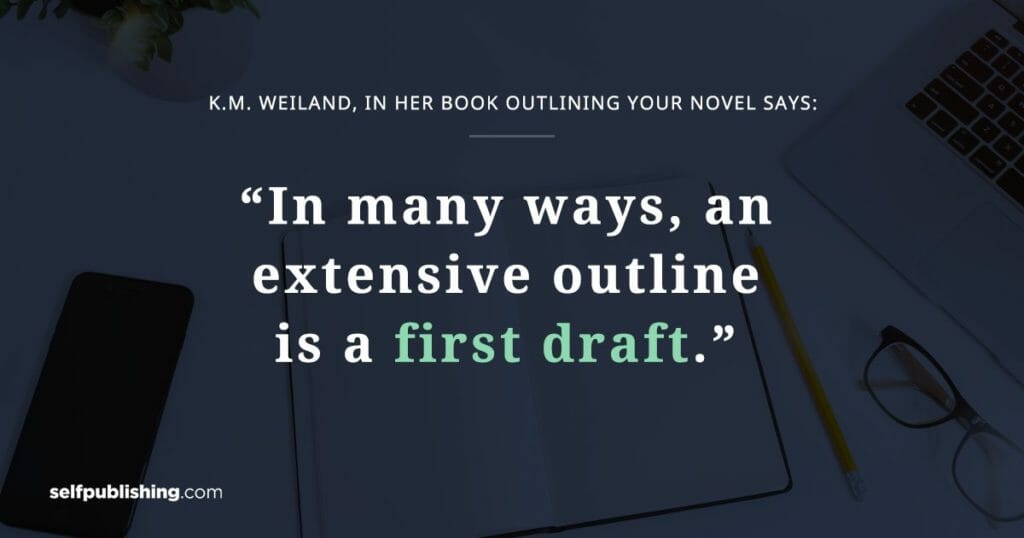
Book Outline Tips
If you’re still struggling to get started, or finish, your outline, we have four best practice book outline tips for you:
- Ask more questions. Questions are your most valuable asset to create an outline for your book. Start with the basic, What? Why? When? Where? Who? And How?
- Refer to similar books. If you’re stuck with getting started, look at the Table of Contents of books in your niche. Do not plagiarize, but use them as ideas. Ask yourself these questions: Where can you add your unique angle? Can you add something more, or different?
- Leave blanks & skip over. If you can’t hash out a particular detail, or have a gap in your outline, don’t pressure yourself to fill the gap. Instead, skip it and leave it blank. It will come to you as you start writing!
- Be flexible. Don’t be rigid with your book outline. The best outlines are those that can be adapted and tweaked on-the-go. The outline is just a starting point, but it’s up to you to refine as you write.
Don’t feel rushed to get your outline done. And always remember your outline is not cast in stone – you can change it how many times you want to. Investing the time in writing a detailed outline will save you time when you write your book.
“The outline is 95 percent of the book. Then I sit down and write, and that’s the easy part.”
Jeffery Deaver
Don’t lock yourself into just one type of outline. Try different types, and feel free to mix and match.
Ready to write your book outline?
If you’re just starting out on your writing journey, give book outlining a try.
It may just enable you to progress forward and avoid the hurdles of the blank page, writer’s block and other stumbling blocks.
Remember the sage advice of Winnie the Pooh…
“Organization is what you do before you do it, so when you do it, it’s not all messed up.” – Winnie the Pooh
And if you’re feeling stuck by this whole book writing and publishing process, consider a self-publishing course where you can be guided through the ins and outs of the entire book writing and publishing process.

